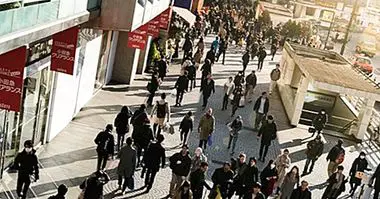The 16 types of discrimination (and their causes)
Discrimination consists in treating a person, group or institution in a different and harmful way . This may be due to different reasons: race, sex, gender, ideas, place of origin, physical appearance, etc.
Discrimination is not something new, since humanity has always discriminated against other individuals because of their resources, origins or intelligence, and even entire peoples because of their different ideas regarding religion or politics.
In this you can find relevant information regarding the different kinds of discrimination that exist.
Causes and consequences of discrimination
Discrimination occurs frequently in all societies. Although public opinion criticizes some forms of discrimination such as racism or machismo, it barely flinches in the face of discriminatory events that can occur on a day-to-day basis, such as those suffering, for example, from obese people.
Discrimination can be an individual or collective phenomenon, and can have different causes. Some of them are:
- The economic or social situation It can be a cause of discriminatory behavior, either due to a bad economic situation or an environment that favors this type of behavior.
- Ideology is one of the main causes of carrying out discriminatory behavior towards certain human groups.
- Fear can cause entire peoples to mobilize in a discriminatory way against some people.
- The submissive and imitative personality it can cause some people not to have enough critical capacity and simply to be carried away by others.
- The influence of the group It also makes many people see discriminatory behaviors as normal.
- The need or interest it can cause discriminatory behavior towards individuals or collectives considered to be inferior.
Discrimination causes the person who is victim to suffer a series of consequences.
On a psychological level, the person may experience anxiety, guilt, depression and feelings of loneliness . But those who are discriminated against can also suffer other problems, such as difficulties in getting a job, school dropout and even death.
Types of discrimination
The causes can be varied and the consequences devastating. But nevertheless, There are different types of discrimination that we must understand . They are the following.
1. Individual discrimination
Individual discrimination is that which makes an individual to another . That is, it is when a person deals differently and negatively with another person, without there being a differentiated contextual reason.
2. Institutional discrimination
This type of discrimination is characterized because they are public or private institutions that carry out some type of discrimination based on sex, race or other reasons. Institutional discrimination is more complex than individual discrimination.
An example can be the exclusive housing or a job offer that asks for the "Catalan" language, excluding those who do not speak that language despite not being a real requirement for the position to which it is aspired.
3. Collective discrimination
A type of discrimination in which an inferiority treatment is given to a group of people . For example, discrimination against immigrants or the LGTBI collective.
4. Structural discrimination
It refers to the discrimination that arises from institutional policies that directly or indirectly favor some individuals and harm others. Although the policies of the institutions must be fair for all, this is not always the case.
5. Direct discrimination
The most well-known form of discrimination and the most visible, in which the person who suffers receives unfair treatment from another person due to its characteristics . It is easier to detect. For example, not accepting a woman in a job just for not being a man, or marginalizing a homosexual person for having a different body language.
6. Indirect discrimination
It is a less visible form of discrimination that often goes unnoticed . For example, the imposition of rules or rules that seem harmless but in practice are not.
7. Negative discrimination
The person who is a victim of discrimination is treated in a discriminatory and harmful manner . For example, by not letting the disabled access to watch a football game.
8. Positive discrimination
Positive discrimination is one in which a disadvantaged group is helped to achieve equity . For example, with a different note in a physical examination of an opposition.This type of discrimination is instrumental, that is, pursues the objective of correcting a historical grievance towards a specific group. However, it is also a source of controversy and social debate.
9. Racism
Racism is one of the best known forms of discrimination . It is also known as discrimination based on race or ethnicity to which the person belongs, and occurs because an individual or several belonging to one race treated with inferiority to another person or persons of another race. For example, discrimination against people of color, towards Jews or towards gypsies.
10. Sexism
Also another of the most well-known forms of discrimination, in which the person who practices it underestimates people of the opposite sex . There are some theories about it. You can know them in this article: "Sexist Prejudice: explanatory theories".
11. Maternity discrimination
Maternity discrimination usually arises in the workplace, as it refers to treating a woman differently (either employee or job applicant) for the possibility of having children. There is a law that prohibits this type of discriminative behavior.
11. Religious discrimination
When an individual or group of individuals receive unfair and unfavorable treatment for not practicing or sharing the religious ideas of the society in which he lives.
12. Discrimination by age
Age is the reason for discrimination . It is usually carried out, especially in work environments, where it is considered that the ideal age to work is from 25 to 45 years. Older people may be left out of the labor market and not interested in certain job offers. It is also called 'old age', although discrimination against young people also occurs in certain contexts.
13. Discrimination due to disability or illness
People can also be treated unfairly because of physical or mental disabilities , or for suffering some disease. The consequences can be both personal treatment and access to jobs, among other damages.
- More information on discrimination against people with functional diversity in this article.
14. Discrimination due to physical appearance
It manifests when the person receiving the discrimination is not very physically graceful . Either by not having attractive physical features or by suffering from obesity. It is known by the term 'aspectism'.
15. Transgender discrimination
It is the discrimination suffered by those individuals who live a gender role that does not match their biological sex . For example, transsexuals. This form of discrimination is also known as 'transphobia'.
16. Discrimination by political ideology
Occurs when an individual or group of individuals receives unfavorable treatment for not sharing political ideas with the society in which he lives. This can generate from social marginalization to repression, as happened during the Franco regime with thousands of communists and Spanish anarchists.



















